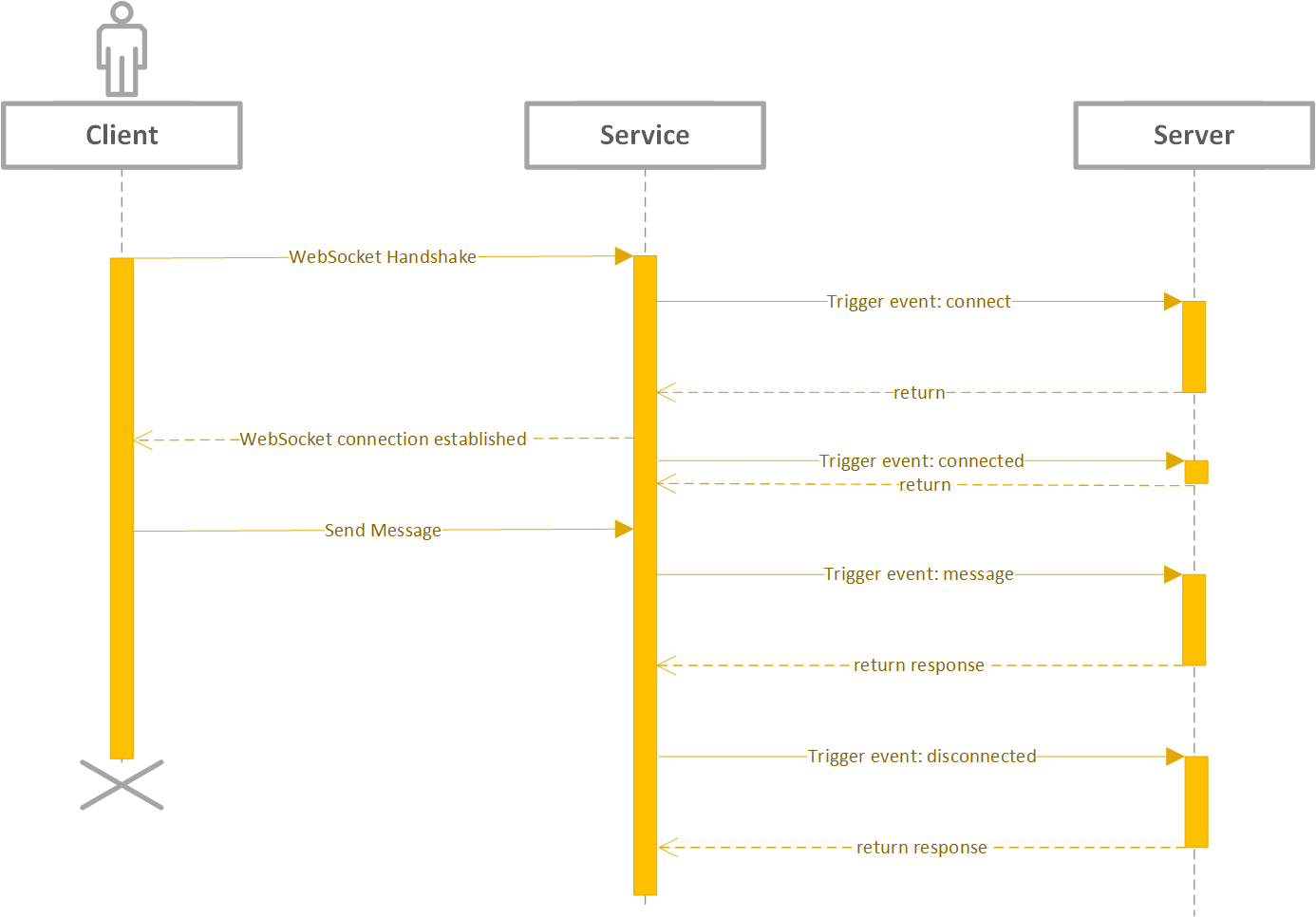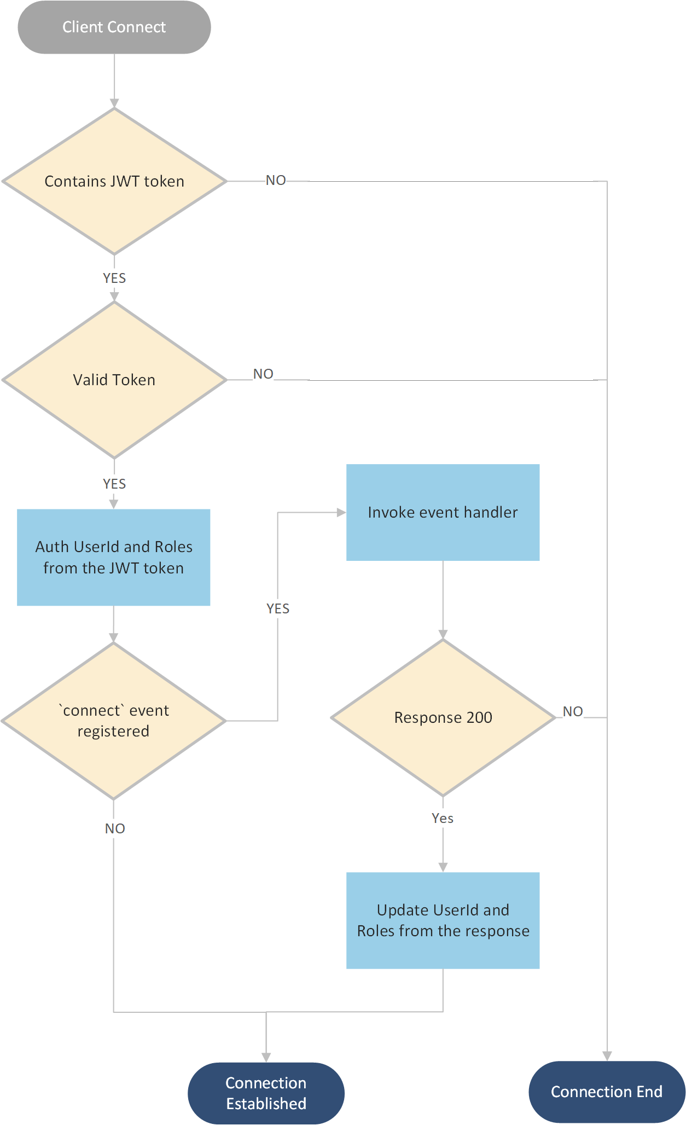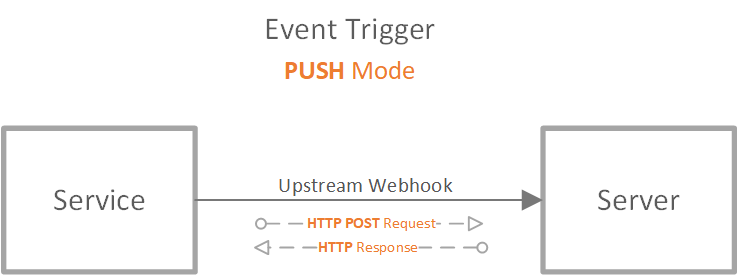Note
Access to this page requires authorization. You can try signing in or changing directories.
Access to this page requires authorization. You can try changing directories.
Azure Web PubSub Service provides an easy way to publish/subscribe messages using simple WebSocket connections.
- Clients can be written in any language that has WebSocket support.
- Both text and binary messages are supported within one connection.
- A simple protocol allows clients to publish massages directly to each other.
- The service manages the WebSocket connections for you.
Terms
- Service: Azure Web PubSub Service.
Connection: A connection, also known as a client or a client connection, it's a logical relationship between a client and the Web PubSub service. Over a 'connection', the client and the service engage in a series of stateful interactions. Connections using different protocols might behave differently, for example, some connections are limited to the duration of a network connection, while others can extend across multiple successive network connections between a client and the service.
Hub: A hub is a logical concept for a set of client connections. Usually you use one hub for one scenario, for example, a chat hub, or a notification hub. When a client connection connects, it connects to a hub, and during its lifetime it belongs to that hub. Once a client connection connects to the hub, the hub exists. Different applications can share one Azure Web PubSub service by using different hub names. While there is no strict limit on the number of hubs, a hub consumes more service load comparing to a group. It is recommended to have a predetermined set of hubs rather than generating them dynamically.
Group: A group is a subset of connections to the hub. You can add a client connection to a group, or remove the client connection from the group, anytime you want. For example, when a client joins a chat room, or when a client leaves the chat room, this chat room can be considered to be a group. A client can join multiple groups, and a group can contain multiple clients. The group is like a group "session", the group session is created once someone joins the group, and the session is gone when no one is in the group. Messages sent to the group are delivered to all of the clients connected to the group.
User: Connections to Web PubSub can belong to one user. A user might have multiple connections, for example when a single user is connected across multiple devices or multiple browser tabs.
Message: When the client is connected, it can send messages to the upstream application, or receive messages from the upstream application, through the WebSocket connection. Messages can be in plain text, binary, or JSON format and have a maximum size of 1 MB.
Client Events: Events are created during the lifecycle of a client connection. For example, a simple WebSocket client connection creates a
connectevent when it tries to connect to the service, aconnectedevent when it successfully connected to the service, amessageevent when it sends messages to the service in its default modesendEventand adisconnectedevent when it disconnects from the service. Details about client events are illustrated in Client protocol section.Event Handler: The event handler contains the logic to handle the client events. Register and configure event handlers in the service through the portal or Azure CLI beforehand. Details are described in Event handler section.
Event Listener(preview): The event listener just listens to the client events but can't interfere the lifetime of your clients through their response. Details are described in Event listener section.
Server: The server can handle client events, manage client connections, or publish messages to groups. Both event handler and event listener are considered to be server-side. Details about server are described in the Server protocol section.
Workflow

Workflow as shown in the above graph:
- A client connects to the service
/clientendpoint using WebSocket transport. Service forwards every WebSocket frame to the configured upstream(server) by default, the WebSocket connection can connect with any custom subprotocol for the server to handle. Alternatively, the client could connect with modesendToGroupand send every WebSocket frame to a specific group. The client could also connect with the service-supported subprotocols, which offer features such as sending events to your upstream, joining groups, and directly sending messages to groups. Details are described in client protocol. - On different client events, the service invokes the server using CloudEvents protocol. CloudEvents is a standardized and protocol-agnostic definition of the structure and metadata description of events hosted by the Cloud Native Computing Foundation (CNCF). Detailed implementation of CloudEvents protocol relies on the server role, described in server protocol.
- The Web PubSub server can invoke the service using the REST API to send messages to clients or to manage the connected clients. Details are described in server protocol
Client protocol
A client connection connects to the /client endpoint of the service using WebSocket protocol. The WebSocket protocol provides full-duplex communication channels over a single TCP connection and was standardized by the IETF as RFC 6455 in 2011. Most languages have native support to start WebSocket connections.
Our service supports two kinds of clients:
- One is called the simple WebSocket client
- The other is called the PubSub WebSocket client
The simple WebSocket client
A simple WebSocket client, as the naming indicates, is a simple WebSocket connection. It can also have its custom subprotocol.
For example, in JS, a simple WebSocket client can be created using the following code.
// simple WebSocket client1
var client1 = new WebSocket("wss://test.webpubsub.azure.cn/client/hubs/hub1");
// simple WebSocket client2 with some custom subprotocol
var client2 = new WebSocket(
"wss://test.webpubsub.azure.cn/client/hubs/hub1",
"custom.subprotocol"
);
Simple WebSocket client has two modes. Its default mode sendEvent follows a client<->server architecture, as the below sequence diagram shows:

- When the client starts a WebSocket handshake, the service tries to invoke the
connectevent handler for WebSocket handshake. Developers can use this handler to handle the WebSocket handshake, determine the subprotocol to use, authenticate the client, and join the client to groups. - When the client is successfully connected, the service invokes a
connectedevent handler. It works as a notification and doesn't block the client from sending messages. Developers can use this handler to do data storage and can respond with messages to the client. The service also pushes aconnectedevent to all concerning event listeners, if any. - When the client sends messages, the service triggers a
messageevent to the event handler. This event contains the messages sent in a WebSocket frame. Your code needs to dispatch the messages inside this event handler. If the event handler returns a nonsuccessful response code, the service drops the client connection. The service also pushes amessageevent to all concerned event listeners, if any. If the service can't find any registered servers to receive the messages, the service also drops the client connection. - When the client disconnects, the service tries to trigger the
disconnectedevent to the event handler once it detects the disconnect. The service also pushes adisconnectedevent to all concerning event listeners, if any.
Scenarios
These connections can be used in a typical client-server architecture where the client sends messages to the server and the server handles incoming messages using Event Handlers. It can also be used when customers apply existing subprotocols in their application logic.
The PubSub WebSocket client
The service also supports a specific subprotocol called json.webpubsub.azure.v1, which empowers the clients to do publish/subscribe directly instead of a round trip to the upstream server. We call the WebSocket connection with json.webpubsub.azure.v1 subprotocol a PubSub WebSocket client. For more information, see the Web PubSub client specification on GitHub.
For example, in JS, a PubSub WebSocket client can be created using the following code.
// PubSub WebSocket client
var pubsub = new WebSocket(
"wss://test.webpubsub.azure.cn/client/hubs/hub1",
"json.webpubsub.azure.v1"
);
A PubSub WebSocket client can:
Join a group, for example:
{ "type": "joinGroup", "group": "<group_name>" }Leave a group, for example:
{ "type": "leaveGroup", "group": "<group_name>" }Publish messages to a group, for example:
{ "type": "sendToGroup", "group": "<group_name>", "data": { "hello": "world" } }Send custom events to the upstream server, for example:
{ "type": "event", "event": "<event_name>", "data": { "hello": "world" } }
PubSub WebSocket Subprotocol contains the details of the json.webpubsub.azure.v1 subprotocol.
In the dafult mode sendEvent of simple WebSocket client, the server is a must have role to receive the message events from clients. A simple WebSocket connection in sendEvent mode always triggers a message event when it sends messages, and always relies on the server-side to process messages and do other operations. The sendToGroup mode only empowers clients to publish messages to groups directly without triggering requests to the server, which is still limited. json.webpubsub.azure.v1 subprotocol empowers clients to do much more without triggering requests to the server. With the help of it, an authorized client can join a group and publish messages to a group directly. It can also route messages to different event handlers / event listeners by customizing the event the message belongs.
Scenarios
Such clients can be used when clients want to talk to each other. Messages are sent from client2 to the service and the service delivers the message directly to client1 if the clients are authorized to do so.
Client1:
var client1 = new WebSocket(
"wss://xxx.webpubsub.azure.cn/client/hubs/hub1",
"json.webpubsub.azure.v1"
);
client1.onmessage = (e) => {
if (e.data) {
var message = JSON.parse(e.data);
if (message.type === "message" && message.group === "Group1") {
// Only print messages from Group1
console.log(message.data);
}
}
};
client1.onopen = (e) => {
client1.send(
JSON.stringify({
type: "joinGroup",
group: "Group1",
})
);
};
Client2:
var client2 = new WebSocket("wss://xxx.webpubsub.azure.cn/client/hubs/hub1", "json.webpubsub.azure.v1");
client2.onopen = e => {
client2.send(JSON.stringify({
type: "sendToGroup",
group: "Group1",
data: "Hello Client1"
});
};
As the above example shows, client2 sends data directly to client1 by publishing messages to Group1 which client1 is in.
Client events summary
Client events fall into two categories:
Synchronous events (blocking) Synchronous events block the client workflow.
connect: This event is for event handler only. When the client starts a WebSocket handshake, the event is triggered and developers can useconnectevent handler to handle the WebSocket handshake, determine the subprotocol to use, authenticate the client, and join the client to groups.message: This event is triggered when a client sends a message.
Asynchronous events (non-blocking) Asynchronous events don't block the client workflow. Instead, they send a notification to the server. When such an event trigger fails, the service logs the error detail.
connected: This event is triggered when a client connects to the service successfully.disconnected: This event is triggered when a client disconnected with the service.
Client message limit
The maximum allowed message size for one WebSocket frame is 1MB.
Client authentication
Authentication workflow
Client uses a signed JSON Web Token (JWT) to connect to the service. The upstream can also reject the client when it's connect event handler of the incoming client. The event handler authenticates the client by specifying the userId and the roles the client has in the webhook response or decline the client with 401. Event handler section describes it in detail.
The following graph describes the workflow.

A client can publish to other clients only when it's authorized to. The roles of the client determines the initial permissions the client has:
| Role | Permission |
|---|---|
| Not specified | The client can send events. |
webpubsub.joinLeaveGroup |
The client can join/leave any group. |
webpubsub.sendToGroup |
The client can publish messages to any group. |
webpubsub.joinLeaveGroup.<group> |
The client can join/leave group <group>. |
webpubsub.sendToGroup.<group> |
The client can publish messages to group <group>. |
The server-side can also grant or revoke permissions of the client dynamically through server protocol as to be illustrated in a later section.
Server protocol
Server protocol provides the functionality for the server to handle client events and manage the client connections and the groups.
In general, server protocol contains three roles:
Event handler
The event handler handles the incoming client events. Event handlers are registered and configured in the service through the portal or Azure CLI. When a client event is triggered, the service can identify if the event is to be handled or not. Now we use PUSH mode to invoke the event handler. The event handler on the server side exposes a publicly accessible endpoint for the service to invoke when the event is triggered. It acts as a webhook.
Web PubSub service delivers client events to the upstream webhook using the CloudEvents HTTP protocol.
For every event, the service formulates an HTTP POST request to the registered upstream and expects an HTTP response.
The data sent from the service to the server is always in CloudEvents binary format.

Upstream and Validation
Event handlers need to be registered and configured in the service through the portal or Azure CLI before first use. When a client event is triggered, the service can identify if the event must be handled or not. For public preview, we use PUSH mode to invoke the event handler. The event handler on the server side exposes publicly accessible endpoint for the service to invoke when the event is triggered. It acts as a webhook upstream.
The URL can use {event} parameter to define a URL template for the webhook handler. The service calculates the value of the webhook URL dynamically when the client request comes in. For example, when a request /client/hubs/chat comes in, with a configured event handler URL pattern http://host.com/api/{event} for hub chat, when the client connects, it will first POST to this URL: http://host.com/api/connect. This behavior can be useful when a PubSub WebSocket client sends custom events, that the event handler helps dispatch different events to different upstream. The {event} parameter isn't allowed in the URL domain name.
When setting up the event handler upstream through Azure portal or CLI, the service follows the CloudEvents abuse protection to validate the upstream webhook. The WebHook-Request-Origin request header is set to the service domain name xxx.webpubsub.azure.cn, and it expects the response having header WebHook-Allowed-Origin to contain this domain name.
When doing the validation, the {event} parameter is resolved to validate. For example, when trying to set the URL to http://host.com/api/{event}, the service tries to OPTIONS a request to http://host.com/api/validate and only when the response is valid the configuration can be set successfully.
For now, we don't support WebHook-Request-Rate and WebHook-Request-Callback.
Authentication/Authorization between service and webhook
To establish secure authentication and authorization between your service and webhook, consider the following options and steps:
- Anonymous mode
- Simple authentication that
codeis provided through the configured Webhook URL. - Use Microsoft Entra authorization. For more information, see how to use managed identity for details.
- Enable Identity for the Web PubSub service.
- Select from existing Microsoft Entra application that stands for your webhook web app.
Connection manager
The server is by nature an authorized user. With the help of the event handler role, the server knows the metadata of the clients, for example, connectionId and userId, so it can:
- Close a client connection
- Send messages to a client
- Send messages to clients that belong to the same user
- Add a client to a group
- Add clients authenticated as the same user to a group
- Remove a client from a group
- Remove clients authenticated as the same user from a group
- Publish messages to a group
It can also grant or revoke publish/join permissions for a PubSub client:
- Grant publish/join permissions to some specific group or to all groups
- Revoke publish/join permissions for some specific group or for all groups
- Check if the client has permission to join or publish to some specific group or to all groups
The service provides REST APIs for the server to do connection management.

The detailed REST API protocol is defined here.
Event listener
Note
Event listener feature is in preview.
The event listener listens to the incoming client events. Each event listener contains a filter to specify which kinds of events it concerns, an endpoint about where to send the events to.
Currently we support Event Hubs as an event listener endpoint.
You need to register event listeners beforehand, so that when a client event is triggered, the service can push the event to the corresponding event listeners. See this doc for how to configure an event listener with an event hub endpoint.
You can configure multiple event listeners. The order in which you configure them doesn't affect their functionality. If an event matches multiple listeners, the event is dispatched to all matching listeners. See the following diagram for an example. For example, if you configure four event listeners simultaneously, each listener that receives a match processes the event. A client event that matches with three of those listeners is sent to three listeners, with the remaining listener ignored.
You can combine an event handler and event listeners for the same event. In this case, both event handler and event listeners receive the event.
Web PubSub service delivers client events to event listeners using CloudEvents AMQP extension for Azure Web PubSub.
Summary
The event handler role handles communication from the service to the server while the manager role handles communication from the server to the service. Once you combine the two roles, the data flow between service and server looks similar to the following diagram using the HTTP protocol.

Next steps
Use these resources to start building your own application: